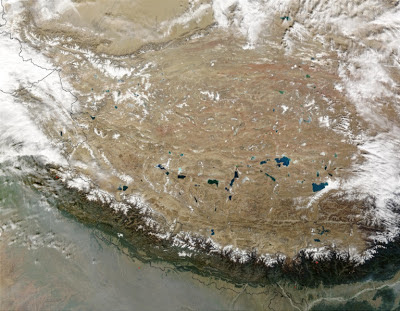Continental Erosion Observations and the Global Flood Model
 |
| Tibetan Plateau - Jeff Schmaltz, MODIS Rapid Response Team, NASA/GSFC |
Tall erosional remnants indicate rapid, continent-wide erosion, which is consistent with the Retreating Stage of the Flood. While the floodwaters were retreating and eroding the continents, resistant rocks were transported long distances, as has been documented for the United States. A similar pattern of coarse gravel transport is evident in the mountains of south-central Asia. These areas are south of the Himalayas, north of the Tibetan Plateau, all around the Tian Shan Mountains, southwest of the Zagros Mountains, and east of the Tibetan Plateau on the west edge of the Sichuan basin. The character of the coarse gravel shed from the rising south-central Asian mountains is best interpreted within the Retreating Stage of the Flood, which also implies that the Flood/post-Flood boundary is in the very ‘late Cenozoic’ in this area, assuming the uniformitarian timescale.
During the Retreating Stage of the Flood, continents and mountains rose above the floodwaters while the ocean basins and valleys sank, causing the waters to flow off the continents (Psalm 104:6–9). During the Retreating Stage, the runoff first caused sheet erosion as the continents rose, which transformed progressively, starting at higher altitudes first, into channelized flow. The channels were probably relatively wide at first (c. 75 km wide), and by the end of the Flood they were relatively narrow (c. 2 km wide). There is abundant geomorphological evidence for this runoff event, which occurred between Day 150 and 371 of the Flood, but the evidence is very difficult for uniformitarian scientists to explain.
Mounting evidence is increasingly portraying the Retreating Stage of the Flood as a period of continental erosion, so most of the sedimentary rocks left behind were likely deposited during the early part of the Flood, before Day 150.To finish reading, rock on over to "Retreating Stage formation of gravel sheets in south-central Asia".